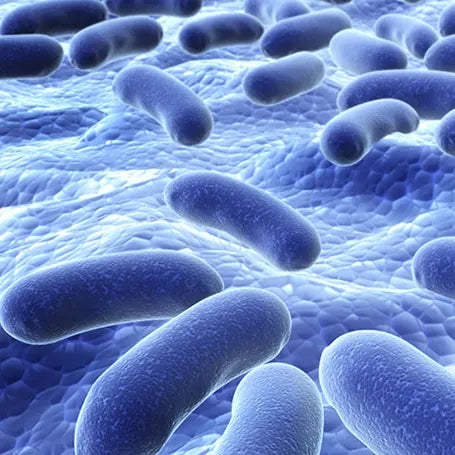
The Microbiome – Protective Shield of Our Skin
The skin's microbiome, also known as the skin flora, plays an important role in maintaining healthy and beautiful skin. In recent years, increasing research has shown how, when the microbiome is in balance, it promotes holistic well-being, fends off skin-damaging factors, and sustainably improves the skin's appearance.
What is the skin microbiome?
The skin microbiome is the totality of all microorganisms or microbes on the skin. As part of the skin barrier, it consists of more than 10,000 different species of microorganisms that live on the skin and protect it from the penetration of allergens and allergens. Most are single-celled or consist of only a few cells. The skin flora includes various bacteria, fungi, and viruses that densely colonize the skin's surface. They are part of the skin's own protective mechanism, which ensures that the bad (pathogenic) germs do not take over, displacing the good microorganisms and keeping them in check.
The composition of the skin microbiome varies from person to person and differs depending on skin type and skin area (e.g., hands, feet, back, face, scalp, armpits, genital area). Incidentally, women's skin microbiomes have a significantly higher diversity of microorganisms than men's.
Amazingly, it is precisely the unique delicate balance of “good” and “bad” microbes that limit each other to protect the skin naturally.
What is disturbed skin flora?
A healthy skin flora consists of a variety of microorganisms such as bacteria, fungi, and viruses that live in harmonious balance and play an important role in protecting the skin. "Good" bacteria (such as Staphylococcus epidermidis) are present in sufficient numbers and keep "bad" bacteria (such as Propionibacterium acnes) in check. When the skin flora is disrupted, potentially harmful microorganisms such as Staphylococcus aureus or Malassezia species proliferate excessively and overgrow the healthy microbiome.
An imbalance in the microbiome can disrupt the skin's immune system, making skin diseases such as acne, eczema, rosacea, or seborrheic dermatitis more likely.
Which skin diseases can occur when the microbiome is disturbed?
90% of all skin diseases can be traced back to a poor microbiome (see draxe.com/microbiome). A compromised microbiome is more likely to cause skin problems as a result of an imbalance between beneficial and harmful microorganisms. These skin problems include:
-
acne
Acne—with inflammatory pimples, redness, and enlarged pores—is characterized by an overgrowth of the skin with propionibacteria. These oil-loving bacteria reside primarily in the sebaceous glands; they break down free fatty acids from sebum, thereby promoting further inflammation. -
Rosacea
This chronic inflammatory skin disease with reddish discoloration in the cheek and nose area is typically associated with altered skin flora. In addition to bacterial inflammation of the hair follicles, infestation of the sebaceous gland follicles by Demodex mites is suspected to be a trigger. -
psoriasis
Psoriasis is associated with reduced diversity in the skin microbiome. This means fewer different types of microorganisms are present on the skin. Instead, an increase in potentially harmful bacteria such as Streptococcus pyogenes, Staphylococcus aureus, and sometimes Malassezia yeast has been observed, leading to chronic inflammation. This inflammation can irritate the skin, causing redness and itching, and further aggravating dryness. -
Atopic eczema (neurodermatitis)
An imbalance in the skin flora impairs the skin's barrier function and causes the immune system to overreact to harmless environmental stimuli. In atopic dermatitis, high concentrations of Staphylococcus aureus have been found in the microbiome, while its antagonist, Styphylococcus epidermidis, and antimicrobial peptides are reduced. -
Fungal infections
Fungal infections are typically characterized by redness, swelling, intense itching, and scaly, weeping skin. Normally harmless fungi like Malassezia, which don't cause problems in small numbers, overgrow the skin's flora. They disrupt the balance of the microbiome by overproducing and causing infections.
-
Seborrheic dermatitis
Seborrheic dermatitis, also known as seborrhea, is a chronic skin problem that primarily affects the scalp, but can also affect the face, ears, and chest area. Seborrheic dermatitis is typically associated with an overgrowth of yeasts of the Malassezia genus. Seborrheic dermatitis is typically accompanied by oily scalp skin, oily dandruff, redness, and itching.
Which factors damage the skin microbiome?
The symbiosis of the various microorganisms forms the skin's environment. A healthy skin environment strengthens the skin's protective barrier and is a crucial factor for your skin's health and protection against infections. The following factors, among others, have a negative impact on the skin's microbiome:
- Excessive and aggressive skin cleansing: Frequent washing with harsh soaps, hot water, or the use of disinfectants kills beneficial bacteria and disrupts the skin's flora. Frequent washing with hot water also dries out your skin and disrupts the microbiome.
- Antibiotics: The use of antibiotics destroys not only harmful but also beneficial bacteria on the skin and in the body, which leads to an incorrect colonization of the skin (dysbiosis).
- Unbalanced diet: A diet high in sugar, unhealthy fats and little fresh food also damages the skin's microbiome.
- Environmental influences: Air pollution from fine dust or excessive sun exposure can disrupt the balance of the skin microbiome.
- Stress and sleep problems: Chronic stress and sleep problems weaken the immune system and impair the balance of the skin flora.
- Synthetic preservatives in skincare: Using skincare with synthetic preservatives such as parabens harms the microbiome.
- Frequent peelings: Frequent exfoliation of the skin with abrasive peeling agents disrupts the balance of the skin flora, especially in sensitive skin.
Which care products strengthen your skin’s microbiome?
With the right care and the right active ingredients, you can positively influence your skin's microbiome and stabilize its delicate balance as a natural protective shield:
Mild skin cleansing
Choose a skin cleanser that's free of harsh surfactants such as sodium lauryl sulfate (SLS) or sodium coco sulfate (SCS). These highly foaming substances disrupt the natural balance of the skin's flora by removing both harmful and beneficial microorganisms.
A good alternative to the usual facial cleansing is the surfactant-free Cleansing Cream or oil cleansing with the myrto Deep Cleansing Oil.
Restoration of the acid mantle (pH value approx. 4.5 to 5.5)
Use cleansing products with a pH that corresponds to your skin's natural pH of approximately 4.5 to 5.5. This helps restore the skin's acid mantle, which is important for a healthy microbiome. All myrto products are formulated to this skin-neutral, slightly acidic pH.
-
Probiotics
Probiotic products contain live bacteria. These microorganisms can positively influence the balance of the microbiome. Probiotic-based ingredients include lactic acid bacteria, Lactobacillus ferment, Bifidobacteria, Streptococcus thermophilus, Vitreoscilla, yeast extract, and Saccharomyces.
-
Prebiotics
Prebiotic active ingredients promote the growth and activity of beneficial microorganisms on the skin. They help inhibit the growth of pathogenic germs. Examples of prebiotics include pectin from fruit and plant fiber and beta-glucan from oats, which are found in all myrto face creams and serums. Beta-glucan is known for its immune-boosting and skin-soothing properties. It is used to regenerate the skin barrier and counteract inflammation. -
Postbiotics
Postbiotic active ingredients include, for example, hyaluronic acid, amino acids, proteins, phospholipids as precursors of ceramides and enzymes obtained through bacterial fermentation.
To achieve the best possible results in your skincare, a combination of prebiotic, probiotic, and postbiotic active ingredients is optimal for the natural balance of your microbiome. While probiotics directly supply beneficial bacteria, prebiotics such as beta-glucan and pectin provide valuable nutrition for the "good" microorganisms. Finally, postbiotics such as phospholipids, proteins, and hyaluronic acid moisturize the skin, act as antioxidants, and reduce the effects of harmful environmental influences. With a combination of prebiotic, probiotic, and postbiotic ingredients, you create optimal conditions to soothe your sensitive, reddened, or inflamed skin and better protect it against environmental stress.
Nutrition for a healthy microbiome
Skin and gut are closely connected, as new scientific findings demonstrate. The body's immune system acts as a mediator between the so-called "gut-skin axis." Studies show that the gut microbiome has a decisive influence on the skin's immune system.
A skin-healthy diet should be rich in probiotic foods such as yogurt, kefir, sauerkraut, and fermented vegetables. The microorganisms they contain, such as Lactobacillus acidophilus, Bifidobacterium bifidum, and Lactobacillus rhamnosus, not only stabilize the gut microbiome but can also be helpful in inflammatory skin conditions such as acne and eczema.





